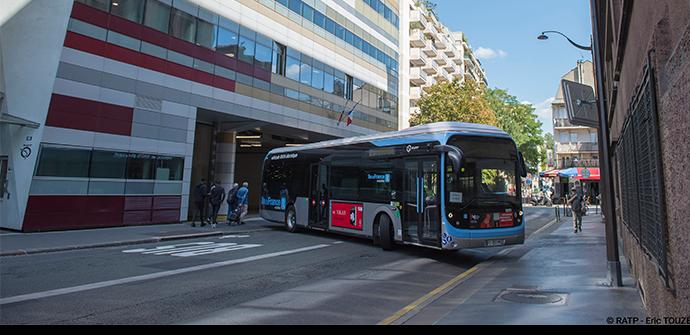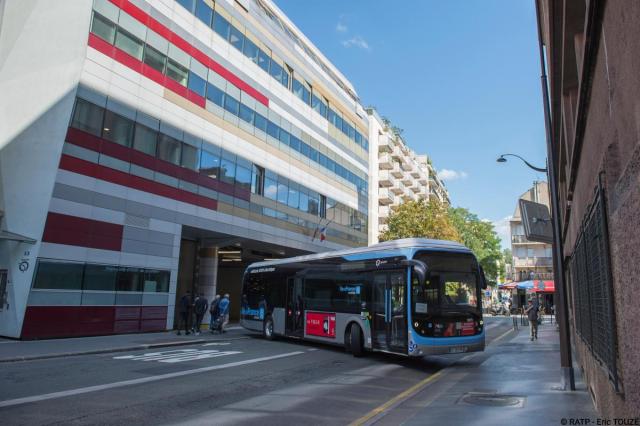The two transit agencies have a history of collaboration dating back to the creation of the Montréal métro. Now, they have signed an agreement to facilitate knowledge-sharing on electrification.
The Régie autonome des transports parisiens (RATP) is a transit agency whose accomplishments include Lagny, a mixed-use complex incorporating businesses, an office tower and a bus garage with a capacity of 220 electric buses, all in a dense urban environment. Now, it has agreed to share its expertise with the Société de transport de Montréal (STM).
“The RATP’s experience with modernizing its bus garages to house electric buses and operating said vehicles, as well as the rich history of collaboration between the two transit agencies, made the RATP a partner of choice for us,” says Pascal Renaud, STM research director for electrification projects.
As part of the agreement, five representatives from the STM electrification program traveled to Paris to learn from RATP Group experts on three main topics: building and fire prevention standards, key infrastructures for electrification, and the operation and maintenance of electrified bus garages.
Learning from a bold technological and ecological shift
In 2014, RATP Group committed to a major technological and ecological transformation with Bus2025, a plan to convert a large part of its bus fleet to electric and biomethane by 2025.
By 2024, RATP Group’s bus fleet will be more eco-friendly, with 4,700 clean buses including roughly 1,100 electric and 1,600 biomethane. Bus2025 will have reduced the RATP’s CO2 emissions from bus traffic by 50%, representing a significant contribution to the organization’s goal of cutting its GHG emissions by 50% as part of its 2025 Challenges plan.
Bus2025 will fundamentally change the RATP’s bus garages and update its entire bus fleet. The RATP will convert 50% of its bus garages to electric and 50% to biomethane by 2025. In total, 25 RATP bus garages will be upgraded by the end of 2024 (not including real estate projects) and filled with electric, biomethane and hybrid buses.
“This is a colossal industrial worksite for the company,” says Josée Danis, Vice-President, Business Development, Canada for RATP Dev, a subsidiary of RATP Group. “The work will involve up to 15 bus garages at a time and will have to be done without interrupting daily operations. It will take all the Group’s combined skills to direct this major energy transition. Sharing our expertise in electric conversion with the STM is a point of pride and a testament to our know-how.”
Deferring to industry best practices
The personalized support that the RATP Group will provide the STM is part of a Europe-wide technological mission aiming to obtain feedback from various transit agencies that operate electric buses. In addition to Paris, the STM delegates will visit seven other European cities to learn from local experts.
While the STM’s current electric buses and related facilities are safe, this professional development process is intended as a responsible effort to learn from the experiences of other industry stakeholders.
Lagny bus garage visit
The learning excursion will conclude on December 9 with a technical visit to the Lagny bus garage, one of two electrified bus garages currently operated by the RATP. A unique feature of the complex is that it incorporates office space for public- and private-sector businesses above its electric-vehicle storage area.
The visit is an opportunity for the RATP and the STM to confer on best practices for the design and operation of underground bus garages. Specifically, they will discuss fire prevention measures, such as division of spaces, battery monitoring mechanisms, fire response methods and liaisons with emergency services.
About the STM
As a public transit corporation, the STM is central to sustainable development in the Montréal area. It operates, maintains and develops an efficient, integrated métro and bus network for a fair price. With roughly 11,000 dedicated employees and partners, the STM offers users safe, reliable, efficient, user-friendly and accessible transit service. The STM is the third-largest public transit corporation in North America, after New York and Toronto. Its four métro lines include 68 stations and 71 kilometres of tunnel, and its fleet of 2,000 buses serve 500 square kilometres on the Island of Montréal. With an annual budget of $1.7 billion, it provides over 80% of public transit service in the Montréal area. For more information, visit stm.info.
About RATP Group
With 16 million trips each day worldwide, RATP Group is a global leader in urban mobility. Present in 14 countries across four continents through its subsidiary RATP Dev, the Group operates daily eight modes of transport (metro, urban and interurban bus, tram, rail, sightseeing, cable transport, maritime shuttle and transport on demand). It is also present in partnership with other modes across the whole new-mobility chain (autonomous shuttles, self-service electric scooters, carpooling, car sharing and smart/connected parking).

